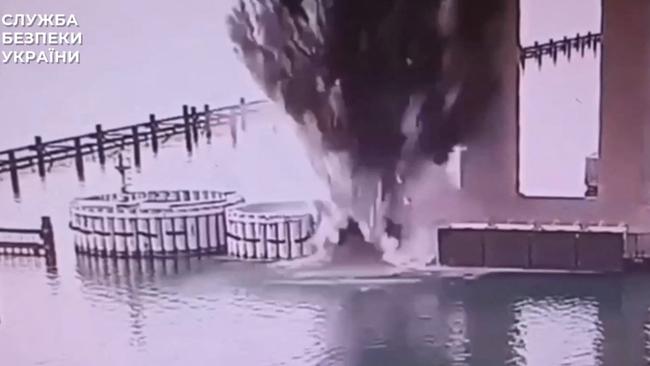
Ukraine’s bold attack on the bridge linking Russia with Crimea, just days after its even bolder attack on Russia’s bomber fleet, sends an unmistakable message to Vladimir Putin that Ukraine is up for the fight if he chooses to prolong this war.
The twin events of the bridge attack and the stunning “Spiderweb” drone attack on the Russian President’s bombers have coincided with a disastrous “peace” negotiation in Istanbul which only served to show how far apart Russia and Ukraine are on any peace deal.
While Donald Trump has remained silent on this week’s developments, the message to the world could not be clearer – Putin has no intention of seeking peace and Ukraine has no intention of rolling over.
Trump is facing a huge loss of face for the faith wrongly placed in his ability to persuade Putin to engage in peace talks. Not to mention the craven appeasement he has shown towards Putin – and his hostility towards Ukraine’s President Volodymyr Zelensky – as a part of that failed process. The world awaits Trump’s response as he decides whether the US will continue to push for peace, or get angry and punish Putin, or simply walk away from the whole mess.
The right decision is clear to almost everyone except perhaps the Trump administration – if Putin is not interested in peace, the US must be a part of a massive renewed Western push to ensure he fails to defeat or subjugate Ukraine.
Putin this week reminded the world exactly how far Russia is from any peace deal by issuing an outrageous “peace” plan and publishing it in full in the state mouthpiece Tass. It called for Ukraine to, in effect, become a vassal state of Russia, demanding that for any ceasefire to occur Kyiv must downsize its army, accept “neural” status between Russia and the West, not accept Western military aid or the stationing of European troops in the country, and recognise Russian as an official language.
What’s more, Moscow demanded it be granted full control of the eastern territories of Luhansk, Donetsk, Zaporizhzhia and Kherson – regions where it does not even have complete military control. The notion that Ukraine would give Moscow its own territory which its troops currently hold as part of any ceasefire is fanciful, and Russia knows it.
So the peace process as it stands is a charade. Given this, the two spectacular attacks by Ukrainian intelligence, on the Crimean bridge and the drone attack on Putin’s strategic bomber fleet, are perfectly timed to send a message to Putin.
The frontline between Russia and Ukraine is effectively in deadlock, with only incremental gains being made by either side. Therefore the best way Ukraine can hurt Russia’s war effort – and embarrass it internationally – is to launch surprise attacks inside Russia.
That was the genius of the futuristic assault on Russia’s strategic bomber fleet by drones which remotely emerged from the roofs of trucks driven by unwitting Russians to the remote airfields scattered across Russia.
Ukraine claims that some 40 bombers – a third of Russia’s critical strategic bomber fleet – were destroyed or damaged by the raids. Russia claims the numbers are less, but the videos do not lie – the attacks caused serious damage to the very same planes Russia uses to bomb Ukraine.
The next challenge for Ukraine’s obviously talented intelligence service is to launch attacks on military infrastructure in Moscow itself. That would be a wake-up call for Putin because what he fears most is a backlash from ordinary Russians if the war comes too close to them and to their lives.
The effective collapse of any serious hope for peace is not surprising. It was always an unrealistic expectation of Trump, although he should not be criticised for giving it a go.
But now Putin has shown his real colours, the West – including Trump – should be doing all it can to encourage brazen attacks by Ukraine like those we have seen on the Crimean bridge and on Putin’s bombers, to remind the dictator there will be a high price to pay for ignoring peace.



